Projects
Click on the planet icons (or simply scroll down) to learn more about my projects in exoplanet atmospheric characterization, theory, and more!
Here are some of my earlier projects as well: using interferometry to measure stellar angular diameters for microlensing surveys, and statistics of planets in the Habitable Zone from the Kepler mission!
How Did HD 106906 b Form? An Analysis of its Atmospheric Chemistry using a Retrieval Model
Formation pathways are still ambiguous for widely-separated companions whose masses lie simultaneously at the high end of the planetary mass distribution and the low end of the companion brown dwarf mass distribution.
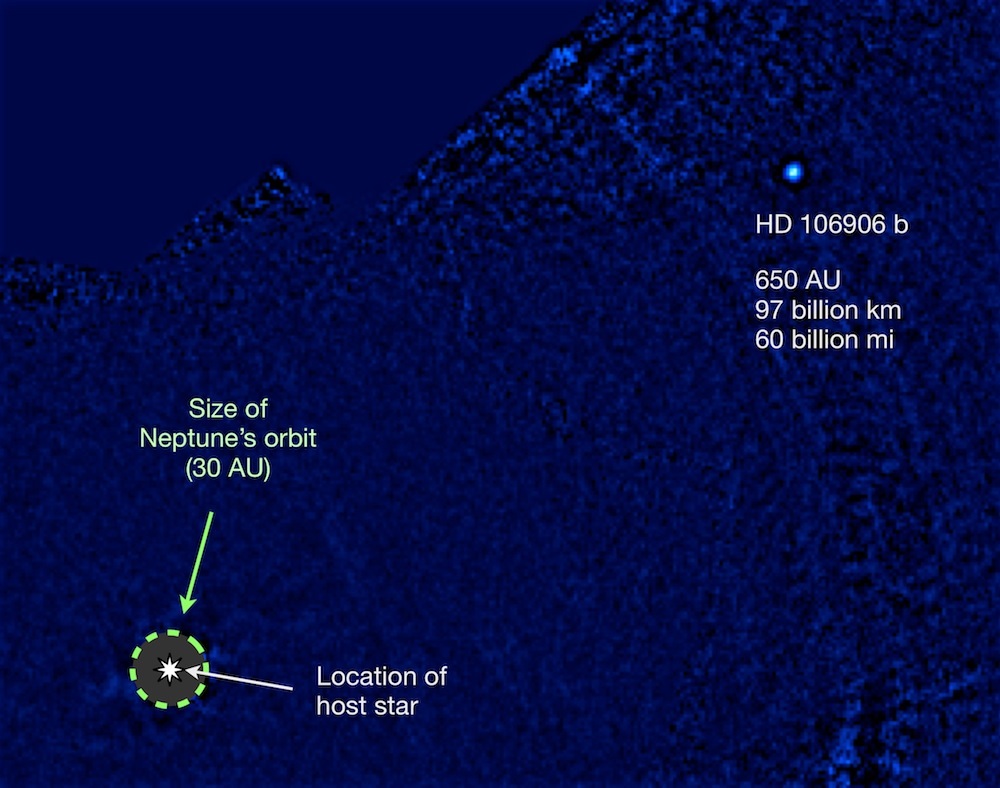
We employ a state-of-the-art atmospheric retrieval code named APOLLO, which was originally created by Dr. Alex Howe and which I have been helping improve and adapt for a greater diversity of planet and companion spectral types. I use APOLLO to model the cloudy photospheres expected for HD 106906 b’s 1700–1800 K effective temperature.
We couple our forward models with an MCMC routine to fit a high-resolution, ground-based emission spectrum (see Daemgen et al. 2017), and ultimately measure its carbon-to-oxygen (C/O) ratio. This ratio is key to understanding how and when HD 106906 b formed in its system. We can therefore help to disambiguate the formation pathways of companions such as HD 106906 b as either brown dwarfs or planets.
Mapping Exoplanets in Eclipse under Various Rotation Rates and Obliquities
Mapping here refers to recovering the map, or spatial distribution, of the brightness of a planet across its visible surface. This is often done for planets which transit across their host stars, and are eclipsed as they subsequently pass behind their stars. The major challenge is that currently we cannot directly resolve these planets, which means we may only measure a 1-dimensional time series of the combined brightnesses of the planet and star.
We often simplify by assuming the planet spin is tidally locked to its host. This is expected to be true for many giant planets orbiting very close to their stars.
I am collaborating with Professor Emily Rauscher at the University of Michigan to understand how our interpretation of the eclipse light curves changes as the rotation varies. This develops on the idea of constructing a
basisof eclipse curves from a combination of map structures, and studying how ambiguity arises when the orientation and speed of the planet's rotation are unknown. A publication on this work is coming very soon; for now, please check out the above talk I recorded in preparation for a colloquium at Ohio State!
Antipodal Anticorrelations: Why Can't You Dig through the Earth and Come Up on Land?
Earth's surface topography counts very few points on land "antipodal" (opposite on the globe) to other points on land. Moreover, this “antipodal anticorrelation” has been a feature of the globe at least since the break-up of Pangaea, Earth's most recent supercontinent.
We quantify this by calculating topographical power spectra, and present evidence that anticorrelation is preferred and maintained by the motions of plate tectonics. That is, mantle convection, as supported through our parallel analysis of plate velocities, appears to inhibit erasure of this anticorrelation on the time scales of supercontinent break-up and re-formation.
This hypothesis gains support from published work that links the plate structure and size distribution to the dynamics of mantle convection and its influence on the lithosphere, and shows preferences for a specific parity in surface harmonic structure. We corroborate this with our own fully-3D models of mantle convection.
The Structure and Evolution of Terrestrial Topography with and without Tectonics: Turning Earth into Venus
With a simple model of erosion and volcanism, we are also able to estimate — if Venus also had active plate tectonics at some point in its history — how long it has been in its current stagnant lid state. Our analysis estimates this transition occurred roughly 600 million years ago.
Effects of Obliquity on Thermal Phase Curves
Paper
On a global scale we expect the energy budget of a planet to be set by its orbit, including the semi-major axis and eccentricity, as well as its rotation, including the spin rate and tilt angle. These combine to set the periodic variation in the planet's sub-stellar point in latitude and longitude.
This work builds on my project on reassessing thermal phase curves. We incorporate the geometry of a freely-varying rotation axis to examine the geometric effect of a planet's high tilt angle on its thermal phase curves. Both the tilt magnitude and orientation with respect to the observer can have first-order effects on empirical parameters such as the amplitude and phase offset. We explore whether the shapes of known planets' photometry lend themselves to this interpretation.

With the help of my thesis advisor Prof. Greg Laughlin, and fellow astronomer Dr. Sarah Millholland, we have also developed an underlying dynamical hypothesis which may allow planets to maintain high tilts, via spin-orbit resonances. The close-in giant planet CoRoT-2 b currently offers the tightest constraints under our obliquity hypothesis, and as a testable prediction implies the existence of a non-transiting outer companion, which can be searched for in radial velocity variations.
Aquaplanets on Eccentric Orbits — Effects of Rotation Rate on Observables
Paper
We explore whether the interaction between orbital eccentricity, which forces variations in heating from the star, and rotation rate, would produce observable differences in phase photometry for Earth-sized aquaplanets. Slower rotation tends to distribute the heating less evenly in longitude, creating different surface patterns of ocean and ice cover.
Observables will ultimately come from upper layers of the atmosphere, rather than surface conditions, so can surface features propagate upward? We construct "water colors", or differences in fluxes between bands that differ in their sensitivity to water-based absorption features. Depending on the viewing geometry and observable contrast, differences in the scale of rotation rate can propagate to differences in phase variations, as well as eclipse and transit depths.
Reassessing Exoplanet Light Curves with a Thermal Model
Paper
The thermal phase variations of exoplanets should tell us about how they respond to the heating from their host stars. At the time of our publication, 13 planets had phase photometry from the Spitzer Space Telescope's IRAC instrument.
In principle the shape of these variations will be set not only by the motion of the planet of the orbit but also the bulk rotation, as well as more finely by the composition and structure of the atmosphere; multi-wavelength observations should probe different layers of the atmosphere.
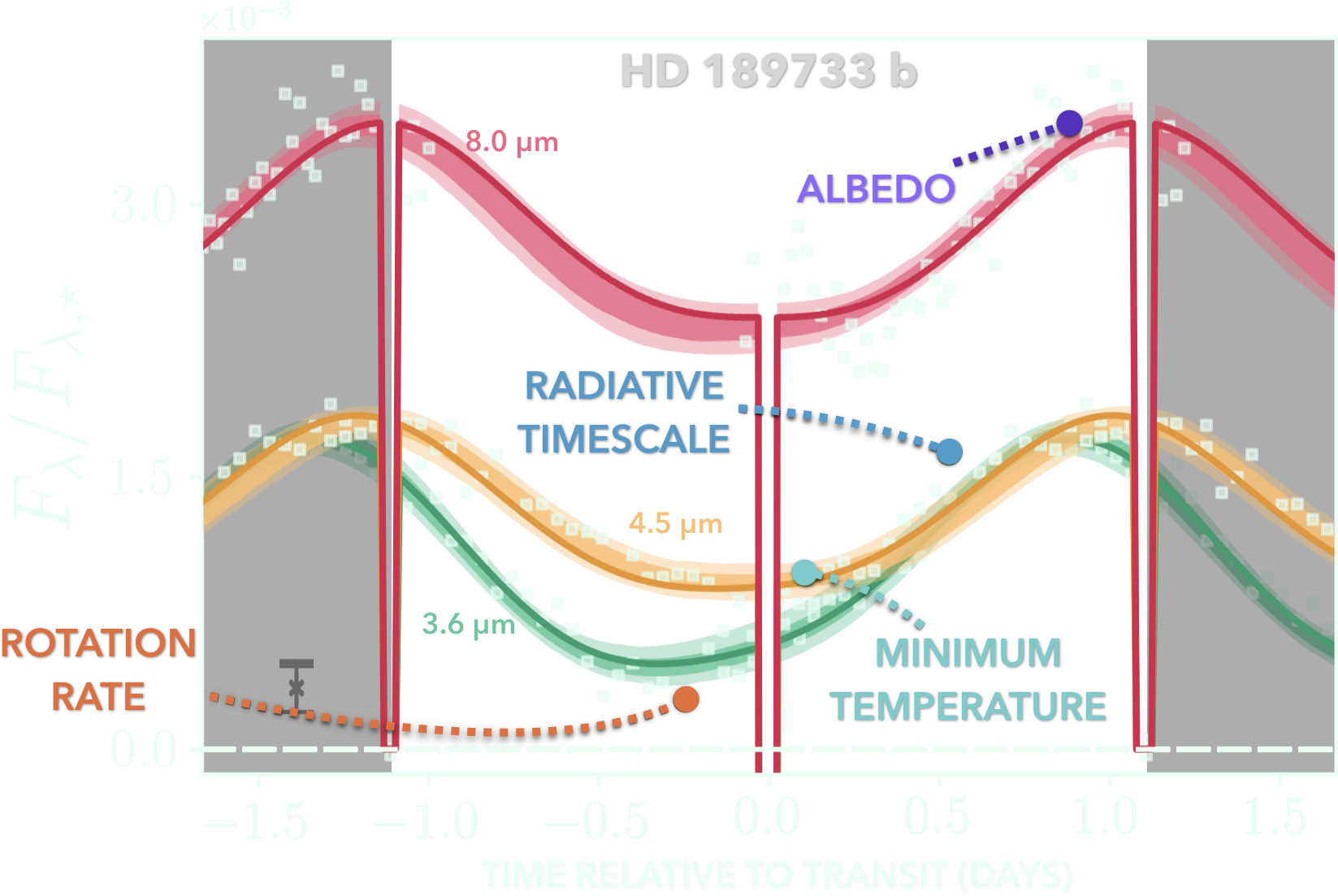
We used a simple thermal model in an attempt to fit the broadest features of each phase curve. In most cases, given the precision of the available data, the thermal approach reproduces the major variations at comparable efficacy with more sophisticated physical models. Regardless of the model used, it continues to be important to accurately characterize the instrumental response, especially so with the launch of the James Webb Space Telescope.
Predicting Stellar Angular Diameters from Photometry
Paper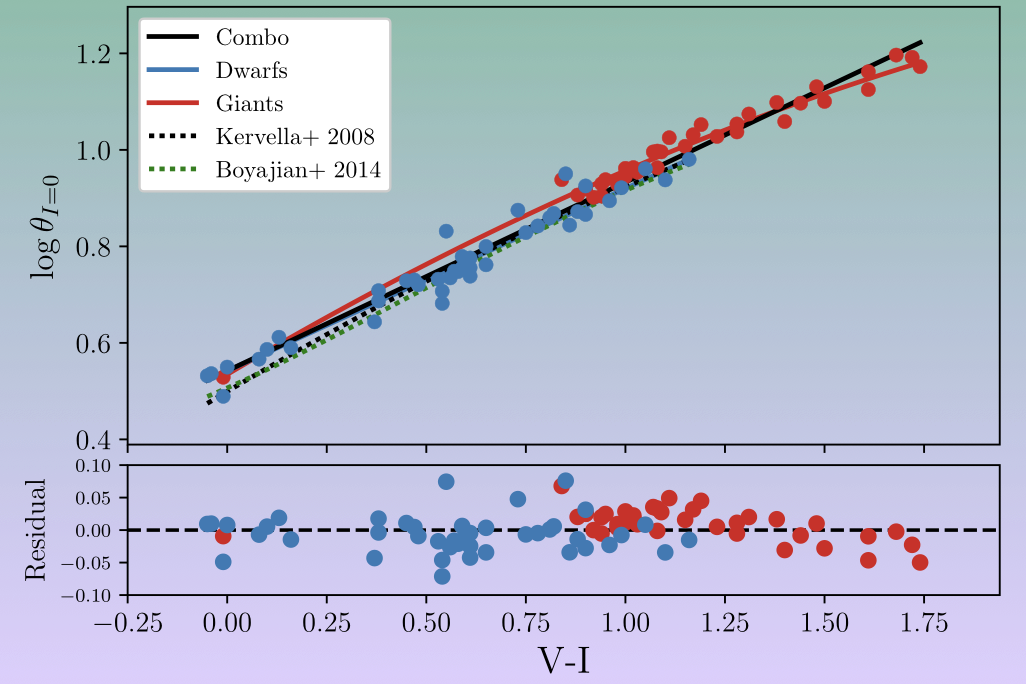
For my first research project at Yale I worked with Professors Tabetha Boyajian and Kaspar von Braun to improve the precision of empiricial relations between apparent stellar angular sizes and photometric colors. The measurement of angular diameters was done using the CHARA Interferometric Array.
Using Kepler Candidates to Examine the Properties of Habitable Zone Exoplanets
Paper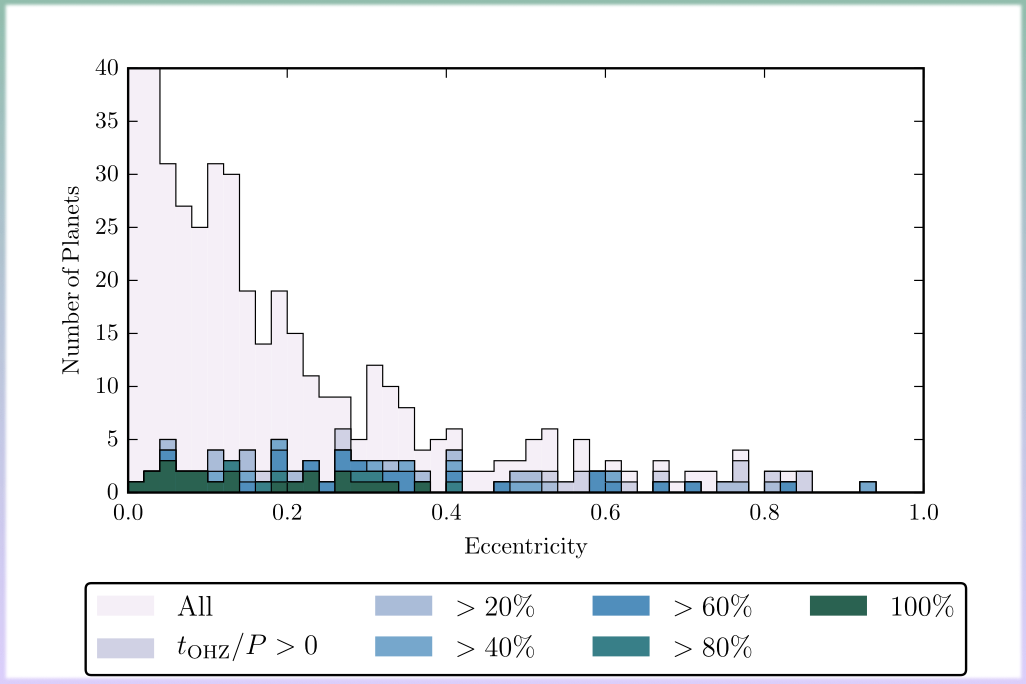
At San Francisco State University I completed my master's thesis in physics with Professor Stephen Kane — this project was the publication that resulted from this work. We examined whether transiting planets known to be in the habitable zones of their host stars differed as a population in their system properties from the population of transiting planets as a whole.

